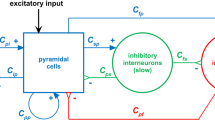Abstract
Connectionist models are usually based on artificial neural networks. However, there is another route towards parallel distributed processing. This is by considering the origins of the intelligence displayed by the single celled organisms known as protoctists. Such intelligence arises by means of the biochemical interactions within the animal. An artificial model of this might therefore be termed an artificial biochemical network or ABN. This paper describes the attributes of such networks and illustrates their abilities in pattern recognition problems and in generating time-varying signals of a type which can be used in many control tasks. The flexibility of the system is explained using legged robots as an example. The networks are trained using back propagation and evolutionary algorithms such as genetic algorithms.
Similar content being viewed by others
References
Alberts B et al (1994) Molecular biology of the cell, 3rd edn. Garland Publishing, New York, pp 24–25 111–135, 721–782
Capanni N (2006) The functionality of spatial and time-domain artificial neural models. PhD thesis, The Robert Gordon University, Aberdeen
Capanni N et al (2005) Artificial biochemical networks. In: Proceedings of the international conference on computational intelligence for modelling control and automation—CIMCA’2005, vol 2, Vienna, November 2005. IEEE, New York, pp 98–102
Curtis H (1969) The marvellous animals: an introduction to the Protozoa. Heinemann Education, London
Grestner W, Werner K (2002) Spiking neuron models. Cambridge University Press, Cambridge
Gurney K (1997) An introduction to neural networks. University College London Press, London, pp 20–24
Hopkin K (1996) dot dot dot dash dash dash. New Sci Mag 150(2030): 40–43
MacLeod C et al (2009) Incremental growth in modular neural networks. Eng Appl Artif Intell 22(4–5): 600–666
Muthurman S (2005) The evolution of modular artificial neural networks. PhD thesis, The Robert Gordon University, Aberdeen
O’Shea M (2005) The brain: a very short introduction. Oxford University Press, Oxford, pp 42–46
Author information
Authors and Affiliations
Corresponding author
Rights and permissions
About this article
Cite this article
MacLeod, C., Capanni, N.F. Artificial biochemical networks: a different connectionist paradigm. Artif Intell Rev 33, 123–134 (2010). https://doi.org/10.1007/s10462-009-9149-y
Published:
Issue Date:
DOI: https://doi.org/10.1007/s10462-009-9149-y




